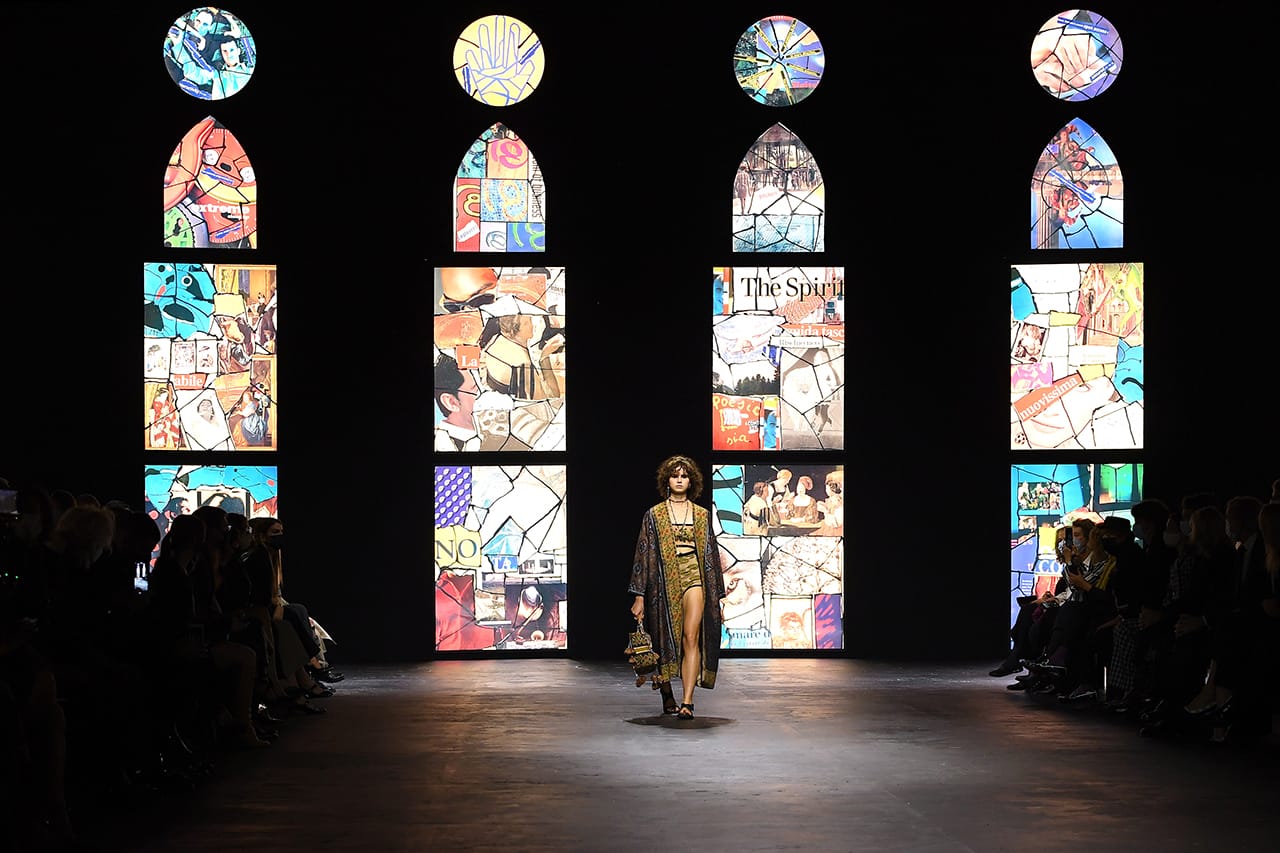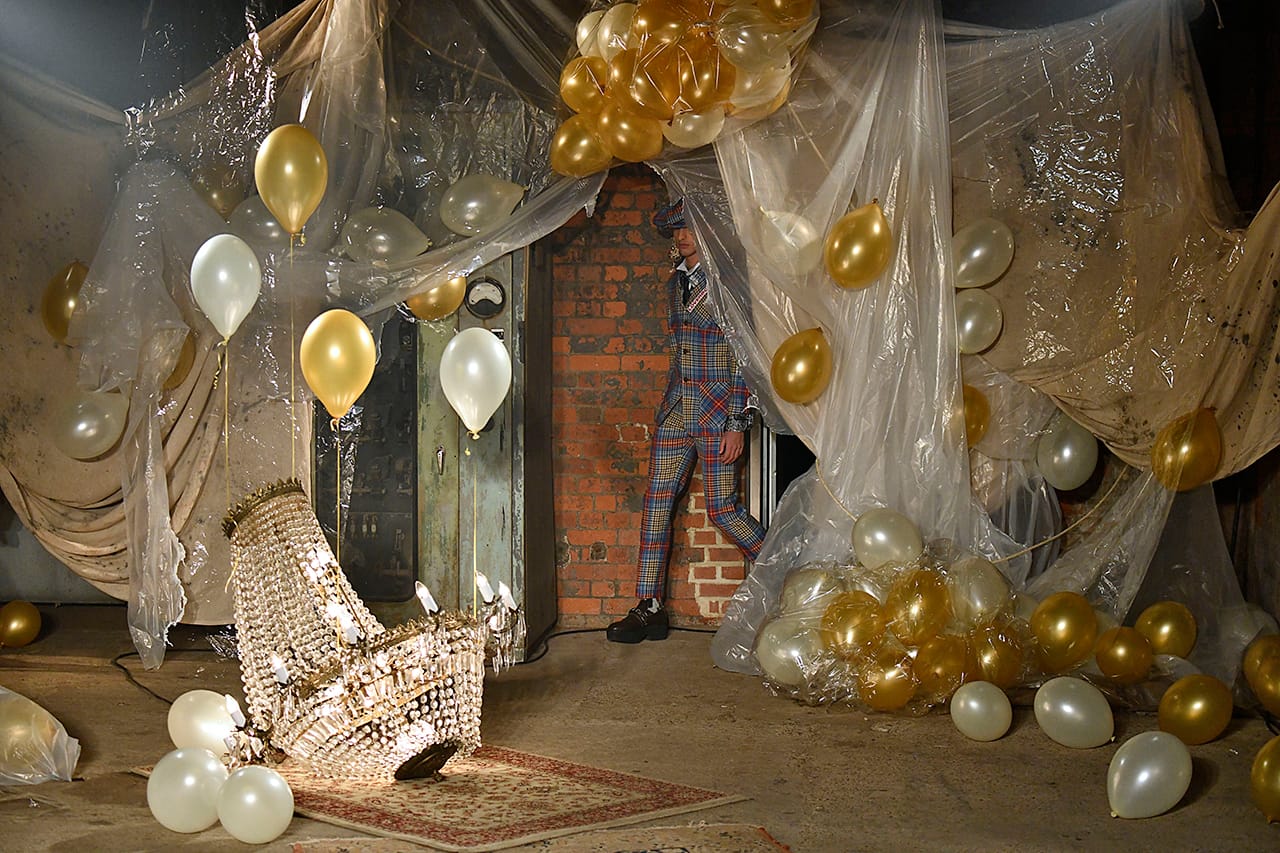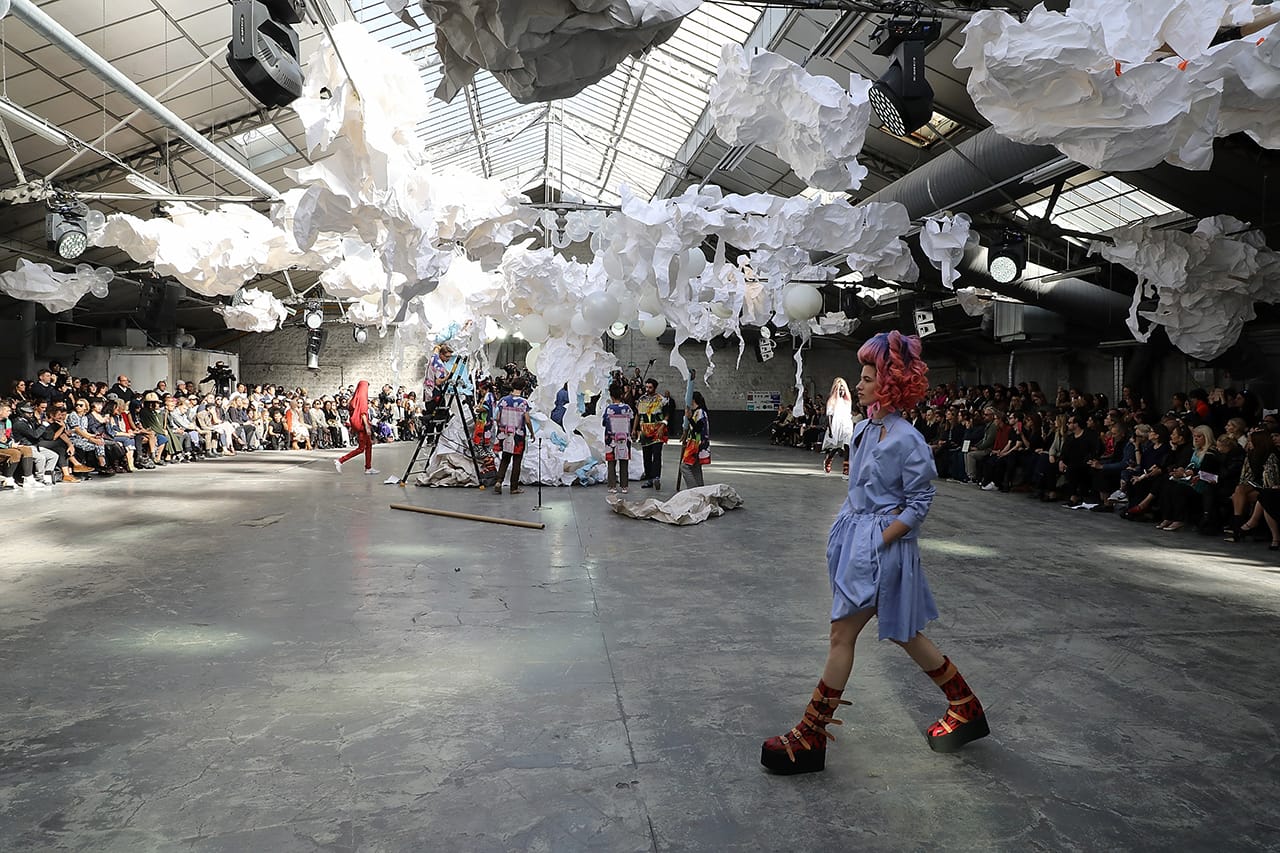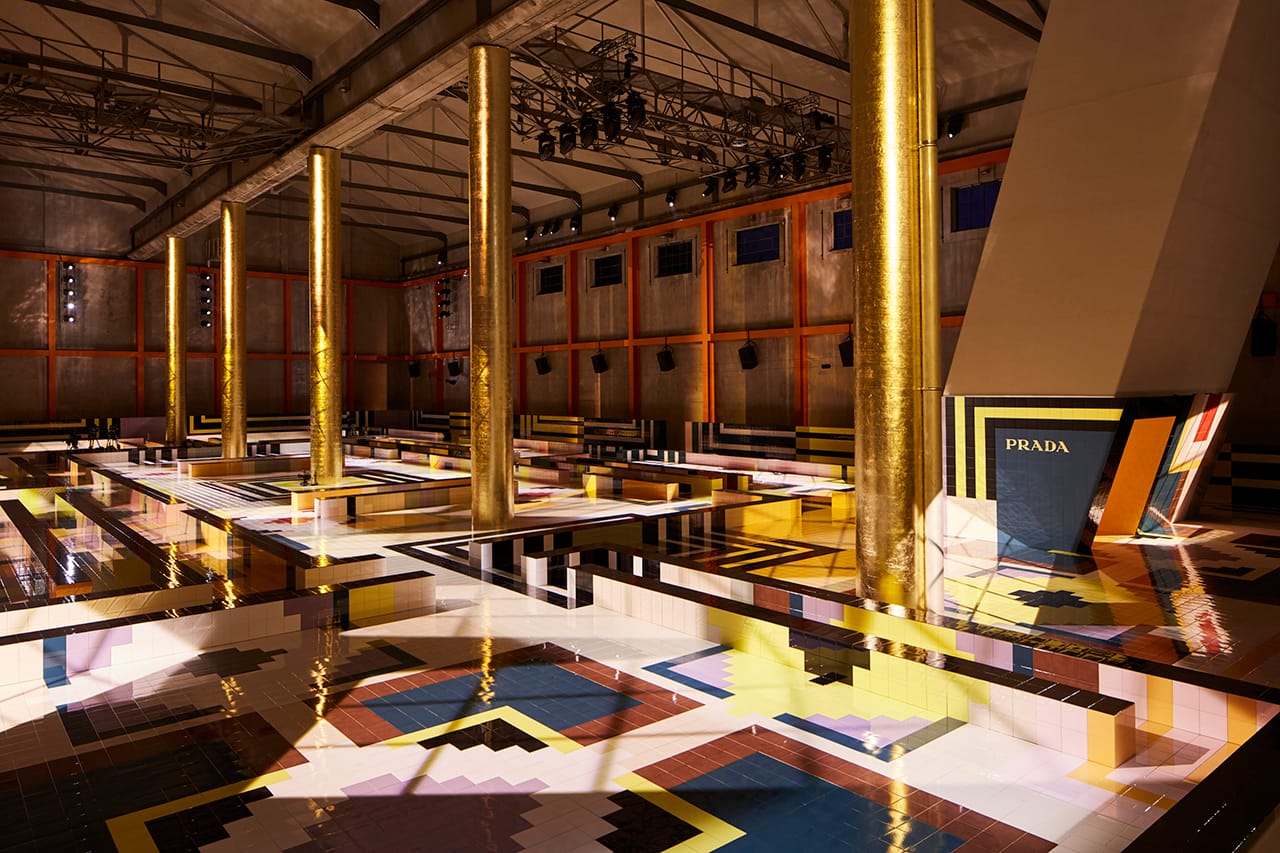It has almost become a cliche to say that this year’s fashion weeks are unlike any before. Over the last six months, two sets of shows — the men’s Spring/Summer 2021 shows meant for June and the women’s SS21 shows which are currently ongoing — have been disrupted by the COVID-19 pandemic and the lockdown measures connected to it.
As a result, brands have found new ways of presenting: videos, lookbooks and even mini-exhibitions have come to the fore in lieu of a traditional runway experience. And while some brands have staged fully-fledged shows (often to an empty audience, or one made up of their own staff), it’s hard not to wonder whether such events might end up as an anachronism in the near future.
“We had always fantasized at some point about designing spaces for no guests.”
So what does that mean for set design? Some of the most memorable fashion shows — from Galliano’s snow-lit wind tunnel for Fall/Winter 2009 to the purple sand dunes of Prada Spring/Summer 2015 — have been defined by their sets as much as the clothes on display. But will there still be a need for such lavish (and expensive) creations in a scaled-down, virtual version of fashion’s future?
What has become clear over the last six months is that a return to previous fashion weeks — with tight schedules, packed-out venues and guests flown in from around the world — is unlikely to return for a long time, if ever. With the possibility of a radical change for the fashion schedule and the way collections are presented, we caught up with three industry-leading names to see how the world of fashion week set design is adapting.
Dior SS21, with set design by Bureau Betak.Pascal Le Segretain/Getty Images
How would you prepare for a normal fashion week?
Gary Card (Vivienne Westwood, Kenzo, Charles Jeffrey LOVERBOY): It all depends on the season, sometimes there might be a couple of smaller brands that I’m working with, or just one larger brand. If I’m working with a small brand I’m usually working with a small team of my assistants and interns, frantically building set pieces in my little studio, trying to figure out ways of how to stretch a tiny budget to accommodate the huge ideas of the brand we’re working with. If I’m working on a larger show for a big brand I’ll usually be working with a big set build company. In both situations I take on a project manager role, overseeing the details and logistics of the set design.
Giulio Margheri, OMA/AMO (Prada): We work mostly on architecture and set design, which means that the preparation for the fashion week for us is the design of the environment where the show is going to take place. AMO, the branch research and design studio of OMA has been collaborating for more than 15 years with Prada on a large number of different projects, among them the design of their fashion shows. The set design is the tangible result of a constant exchange between the two companies. This process normally takes place four times per year in Milan designing the set for the Prada shows, and two times in Paris for the Miu Miu ones. Each of the development of the set follows similar principles, yet it is always very different. It is normally about 10 or 12 weeks long.
During the first month the work revolves around finding the concept for the showspace – we usually exchange many different ideas, presented in the form of art and movie references, rough collages and physical models. The concept phase is both about defining an atmosphere and its architectural configuration.
Alexandre de Betak, Bureau Betak (Dior, Helmut Lang, Galliano): There is no formula as shows are all different. Our job is to help brands and designers remain as different as possible. Some give us a brief, some of them we’ll start a year early, some later. In many cases, we start right after the previous show for the same brand. Some are very precise and have a mood board, some shoot ideas from the collection, some give us words, some give us nothing. Some don’t even give a brief. It’s an ongoing relationship where you know the next show will happen in x amount of months, and you start thinking as a team and work with the designer. There’s a lot of different ways to approach it.
Prada SS21, with set design by OMA/AMO.Agostino Osio
How has your practice changed since the pandemic?
Card: In all honesty there hasn’t been any offers to do shows this season, so I can’t say.
Margheri: The lack of physical contact is the most tangible of the impacts: working from home, teams are disconnected, dependence on Internet speed, no traveling allowed, cancellation of physical events… This is not only less efficient but also less dynamic which is a relevant part of our work. However, there is now a common understanding that this situation will still last for a long time, which forces us to rethink our plans and projects within this “new normal.” In June, after a few months of lockdown, suddenly some requests for new temporary projects came in – aligned with the relaxation of the security measures — which in a way proves the willingness of the industry to keep moving forward.
De Betak: It changed everything. We’ve started working on a show really late because in spring we didn’t know what was going to happen, no one was in a mood for planning, when we started seeing the end of lockdown and started having hope, we spoke with a lot of designers and brands and we started looking at digital-only solutions.
We worked under confinement and did a lot of research for what we could bring into projects and help make things possible in this new world. However, even though we researched all those new technologies and ways of doing things, better digital amplification, we also came to realize that we found it more efficient and interesting to still have an event. I come from the world of creating emotions and memories and live experiences, and of course I’ve been working for years on greater digital amplification, but this still needed live experiences rather than strictly films.
Charles Jeffrey Loverboy FW19, with set design by Gary Card.Victor Virgile/Gamma-Rapho Via Getty Images
Have you taken on different kinds of work due to the situation?
Card: Yes, the current situation has allowed me to concentrate on my own artwork, I have two shows I’m currently working on, a sculpture show here in London and a series of paintings for an exhibition in China. This is the first time in my adult life that I’ve been able to concentrate on my own work completely uninterrupted, it’s been a liberating experience.
Margheri: The work mutates. I wouldn’t say we are taking new kinds of work because of the situation, but rather that some projects that we were working on changed and took different forms because of the current pandemic and the new restrictions in place. It is inevitable now to take into account the current conditions when designing events. At the same time we constantly try to have a proactive approach towards the situation, considering the constraints as a tool to design rather than a limitation.
De Betak: We started a sub-company a few years ago called Bureau Future, which was years before the pandemic. It’s a digital content creation company which we created to better amplify physical shows because they became global a long time ago, which we’d stream live on digital media. We believed we had to do it better and more efficiently than just filming. Luckily, we’ve been working for years on trying to make more out of what we already did, the show itself.
These past months some subjects that are mostly or strictly physical became mostly digital. There’s a shift of balance, but we still address the things we have done digitally with attention to physical detail in the culture of real, physical experiences, even if it’s going to be transmitted digitally.
“It’s silly to think that a fashion show is a futile, immoral thing.”
Have you been helping brands or designers present collections in new ways?
Margheri: We have been working on designing sets that for the first time had different paradigms, spaces where the lack of guests meant we lost the restrictions dictated by their presence, and the needs and rules attached. Instead, the sets have become places where the work will mainly be broadcasted. A fashion show presented through a live streaming is nothing new, but that was always in addition to a limited number of people physically attending the show. In the design process the presence of such a small group has a very big impact on the end result of the set.
We had always fantasized at some point about designing spaces for no guests in order not to compromise the design to accommodate functionality, and to some extent this season forced us in that direction.
De Betak: We are still experimenting and we will be for a very long time, we are at the start of a new era where every show from now will always be a hybrid. From now, and even after the vaccine, I am convinced that we won’t go back to the same situations. We’re never going to show to all of the media of the world, every time, every fashion show. I think that the system of seasons is over, and it should be over — for sustainable reasons, economical reasons, and interest reasons it should be over. People are getting bored by them, and I can’t blame them because there are too many of them.
So in a way, the new world is going to help the audiences regain interest. No one will ever see everything, everywhere, ever again. For that reason everything will be a hybrid, because everything will only be seen very fast, digitally, there will be only a small physical audience.
Jacquemus SS21, with set design by Bureau Betak.Pascal Le Segretain/Getty Images
Have you worked on any virtual fashion week presentations? What was that like?
Card: Actually not yet. Sadly the idea of working virtually does in lots of cases remove the set designer from the process, as the sky’s the limit as to what you can produce virtually, the logistics of creating a set that fits and works in a venue don’t apply, logistics for a fashion show are 80 percent of the job. Hopefully brands will see the value of set designers as ideas people that can help them realize their visions virtually.
Margheri: Not really, we worked on physical sets that didn’t have guests.
De Betak: I believe in virtually transmitting a physical emotion. The first show we did after lockdown was the Jacquemus show in the wheat fields close to Paris in early July. It was a real show with a small audience. It was a live experience but it went out digitally. Then we did the Dior in Lecce, which was the first very large show, a big production, with absolutely no audience. It was a very important experiment in fact because one would wonder why you’d put on such a big show and no one will see it live. The truth is: the answer speaks for itself. They engaged more by looking at something that actually happened than by the way of previously looking at a show.
I’ve spent my life working on shows, and I hope and believe I’ve helped reinvent them and revolutionize them. Together with my team, we try to reinvent it with all different designers that we’ve worked with for a really long time. John Galliano for 16 years, or Viktor & Rolf, Raf Simons, Dior, Saint Laurent. Those brands and designers are examples of very specific types of fashion shows, very specific visual identities. Now, we’re in a time where we have to reinvent for each one of them.
Are you thinking about shows differently post-COVID? Do you think there is still a need for them?
Card: This is a question I’ve been asking myself for some time, the fate of the fashion show has been in question long before COVID, there is a huge amount of waste that’s created with a show and I think we’ve all collectively become a lot more conscientious about that. So I think figuring out new ways to present collections, virtual or otherwise, is definitely a positive thing. Having said that, you just can’t beat the theater of a good fashion show, when everything clicks together as planned they can be exhilarating experiences, and I’ll miss that feeling. Do we need them? Maybe not, but I guess that’s like saying do we need theater when we have TV.
Margheri: Looking at the current situation, what we could call “post-COVID condition” is not here yet, and it is hard to predict when and how it will manifest. We will see how the situation evolves, and what will be possible and relevant to do in the coming months or seasons. There is the will and the necessity to get back to collective events, I could imagine us living in strict regimes of health screening, with people constantly being tested. During the latest fashion week in Milan, some clinics were flooded with young models and people from the fashion industry.
Each of the figures involved in the field had to go through the inevitable proof of negativity to access their normal routine, a routine that entails an environment shared with many people at the same time. And this is probably a direction that will increase and develop with more accessible health checks linked to many of the activities that require people to gather. These past months and the many different strategies that have been adopted by the industry to present their collections in this unprecedented situation prove that shows and the presentation of the collections is still relevant and necessary.
De Betak: There is a need for brands and designers to put them on. The larger question is: is there a need for shows for the world to go round? No, there never was. However, fashion shows became such largely-seen mediums that, from my part and I am very lucky to work with who I work with, they help provide for creative partnerships and creative reasons. We create moments and events and emotions that are seen very largely, they have a very important immediate cultural effect on people.
Vivienne Westwood SS19, with set design by Gary Card.Pierre Suu/Getty Images
What is the role of set designers in this new digital format?
Card: Hopefully it will be helping those same brands flesh out those virtual concepts, so much of what we make is on cad and sketch up, so we’re almost designing in virtual spaces anyway, we have a very good grasp on how a space should feel and how to create an immersive experience, so it should be a very clear transition.
Margheri: We have been working on designing the absolute environments for a character to move in, a built counterpart to the fashion collection. In that sense regardless of the form that the space will have, there will always be a need to design an atmosphere. As designers we will probably need different or additional sets of skills or collaborators, professionals able to translate ideas to inhabitable digital spaces, video games, apps… But I still consider designing a space a relevant added value.
De Betak: I’m not really a set designer. My goal is to help create the language for these brands, create concepts from the set to the lights, the music, the choreography, the casting, the hair, makeup, the special effects, you name it. It’s a whole thing. Me and my team, we answer the designer’s needs with a full concept. When we start a relationship with a new client, our role is to design a language, to design the rules and the language that we follow to create an identity together. I think that this new need should reshuffle the cards and open the door for every designer and brand to come up with new ideas and ways of doing what they do. I think each one of them could, or should, be more different than they were before.
I am convinced that there will still be a fashion show. Maybe not in a fashion week, but at some point when it comes to fashion in an efficient, timely, engaging and still fashion way, you’ll want to do it. I think that the fashion show format is something that you don’t need to do all the time. But at some point you’ll want to see a fashion show from a fashion designer. I don’t think that’s going to die, the digital experiments that were done in spring and summer were amazing, some of them, but I don’t think any of them are strong enough that you can only do digital and never do something live ever again.
Prada SS20, with set design by OMA/AMO.Agostino Osio
What have been the main challenges about operating in the “new normal”?
Card: I’ve got to be honest, social distancing when building sets so far has sometimes been challenging. It’s hard to keep your distance when so much of building something is about working closely with a team, but we’ve been working it out. I find that wearing a mask all day, although essential, is pretty annoying, I’m constantly adjusting it, sometimes my breath channels up the mask, fogging up my glasses.
Margheri: Many of the processes that were well established and up to speed, suddenly needed to be re-thought, without the time to redefine them, just by doing them. This means some of the results were a good learning experience and could potentially be adopted also in a post-covid time. As the pandemic situation has been constantly evolving in the past months, we started working on sets with good vibes and positive trends, while ending the design in a moment with the higher rate of cases in Europe and some areas moving back to full lockdown conditions. In terms of design this means that the brief itself constantly mutates according to the situation.
Moreover, travelling and meeting has been way more complicated in these last months, and even if we tried to reduce it as much as possible, it is still very important to see the materials, get a sense of the proportions and feel the atmosphere while testing the mock-ups. With all the problems and struggles this situation is generating, it is very interesting to see how in many different fields we are forced to experiment and find new solutions. The fashion industry was forced to reimagine pre-established dynamics such as the fashion shows, and it is interesting to note how each brand has interpreted the moment, thinking of new formats and ways of presenting their creations, trying to be relevant and contemporary.
De Betak: There are challenges of quantity, symmetry, measures, things like that. But it’s also a moral challenge, which for me right now is the biggest one. We are doing a physical show with an incredibly reduced live audience, and a lot of people are attacking it, saying it’s completely immoral, irresponsible, that people can’t be socially distanced. It’s no different than people sitting in a restaurant next to each other or catching a train or subway.
Operational challenges are just practical and a pain in the ass. Moral ones are more challenging. It’s the bigger question: should the world stop turning? I strongly believe the world will change, like everyone else says, it does. But I also believe that you can’t change the entire world from one day to the next. Yes, the world of fashion needs rethinking, and we’re working very hard on sustainability programs, but I also believe that if you stop everything, an entire industry, then tens of thousands of people with families won’t have an income. It’s a very silly thing to think that a fashion show is a futile, immoral thing. Before anything else, it has the purpose of communicating brands that create, that all together are part of an industry that provides for people in the world.
Source: Read Full Article





